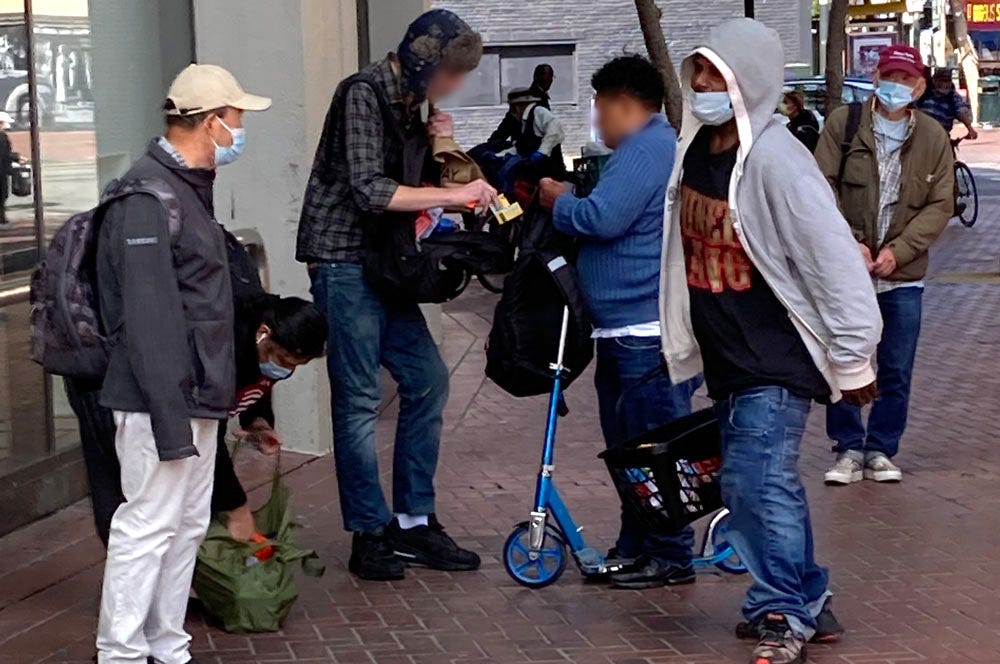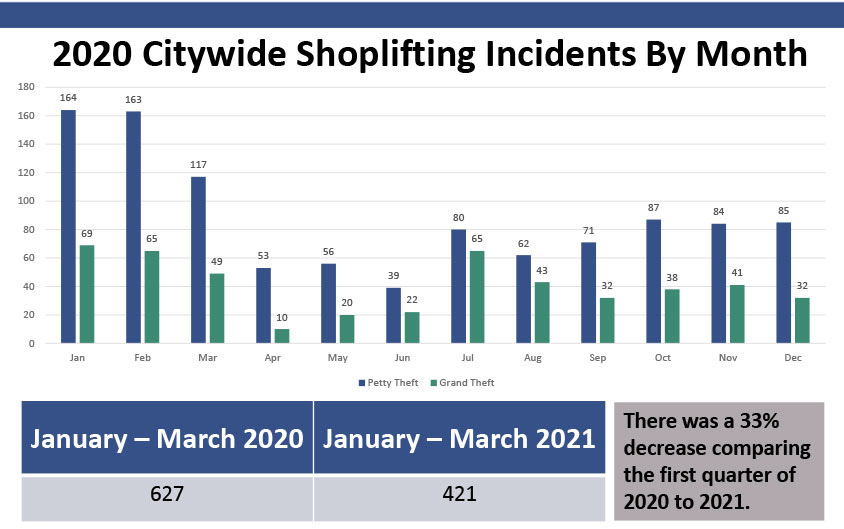While “US property crimes declined 23%,” SF’s increased 42%
Preposterous Chronicle & Examiner: Only 6 Shoplifting Incidents Occur Daily in SF
This article was published in the Westside Observer in July 2021.
Retail shoplifters bargain with wholesalers at 7th and Market Streets
To promote the progressive narrative on decarceration and defunding of law enforcement, it is essential to mask surging crime rates in San Francisco. Despite numerous viral YouTube videos documenting San Francisco’s shoplifting incidents, in a June 25th Chronicle and a June 29th Examiner article, Susie Neilson and Michael Barba, respectively, wrote about falling shoplifting crimes rates. District Attorney Chesa Boudin immediately congratulated himself by retweeting Neilson’s article, “We work hard to protect local businesses.” But has shoplifting really declined in San Francisco?
Neilson correctly cited CA Department of Justice (DOJ) statistics, while Barba accurately referenced a May 13th SFPD report. Perhaps I am the only person who divided the 2019 (a non-Covid year) total shoplifting crimes of 2,362, by 365 days. According to the SFPD report, for the entire 49-square miles of our city, only six people shoplifted per day. Each law enforcement officer I spoke to describe the 6-per day figure as being comically inaccurate. I agree.
Newspapers report the quantity of SFPD incident reports, not shoplifting crimes
The SFPD report only references shoplifting offenses that required SFPD officers to prepare an incident report. That means either the shoplifter fought security, committed additional crimes, or stole more than $950 worth of items. It’s not that SFPD’s report is erroneous, it’s just not a representative statistic.
In a parallel statistic, SFPD only completes incident reports for traffic accidents when there is an injury. Therefore, thousands of noninjury accidents are handled civilly without SFPD reports the same way thousands of shoplifting offenses are handled without reports. An insurance company would not determine premium rates based solely on SFPD incident reports, nor should readers interpret SFPD shoplifting reports as anywhere near the total picture of the shoplifting epidemic in San Francisco.
Do the Chronicle/Examiner conflict with the obvious?
In San Francisco, over the past 18-months, 17 San Francisco Walgreens have closed because of the financial losses due to excessive shoplifting. If we were to assume Walgreens was the exclusive victim of all of SF’s 6 daily shoplifts, that means Walgreens’ accountants made a major business decision to close those stores because they only suffered a twice-per-week shoplift. Doubtful.
James, one of the security guards at a Walgreens on Market Street, told me he documents photographs of the shoplifters he catches on his cellphone. On the day of Neilson’s 6-per-day article, James caught 23 shoplifters by himself. He said he averages catching 15 shoplifts per day, but he knows he misses many of the shoplifters.
Bloomingdales and Nordstrom employ security guards at every entrance of their stores. On the same floor as the Bloomingdales, Michael Kors, Panerai, Rolex, Tourneau, Rio Valentine, Burberry, Kate Spade, and Abercrombie all employee security guards at their doors, while the mall also provides an additional layer of security in yellow jackets. It is hard to conclude that all the stores’ professional analysts are spending millions on security payroll to defend against only 6-shoplifting crimes per day.
Decreasing shoplifting stats are inconsistent with San Francisco’s property crime surge
In her Chronicle article, Neilson supports the 6 shoplifters per day by conflating a national declining property theft rate as evidence that shoplifting also must be declining in San Francisco:
“Still, shoplifting has been declining in the city since 1985, according to data from the California Department of Justice. That’s in keeping with broader national trends: Between 2009 and 2018, overall property crime in the U.S. declined by 23% according to the FBI.”
First, apparently the CA DOJ’s 1985 shoplifting base of 14 shoplifts per day, came from the same unrepresentative SFPD incident report statistic.
Second, and extremely shocking, while the ten-year national property crime rate dropped 23%, San Francisco experienced a 42.6% surge (34,509 to 49,214). For those of you turned off by numbers, let me reword that statistic: Between 2009 and 2018, San Francisco negatively diverged from a national trend by 65 percentage points! Consistent with that statistic, which makes many view SF as lawless, we are supposed to believe shoplifting was simultaneously declining?
Proposition 47’s contribution to property crimes
On Twitter, Ms. Neilson defended Proposition 47’s perceived negative effect by claiming the initiative recategorized felonies into misdemeanors, but that it should not have suppressed lower property crime figures. That is theoretically true.
However, Prop 47 legally prevents police officers from arresting shoplifters of merchandise under $950. A civilian witness must make a citizen’s arrest, and then SFPD issues the thief a citation on a traffic ticket. The civilian potentially loses a day of work to go to court and is civilly exposed for a false arrest. James at Walgreens said, “Why should I make a citizen’s arrest if the DA is just going to kick the case anyway? We just return the stolen merchandise to the shelves.”
I spoke to several SFPD officers that echoed James’ sentiments, “Shoplifting crimes are dispatched as such a low priority call, by the time we get to the store, the clerk’s shift has ended and so no report can be made. Or the store clerk knows that the thief will not be prosecuted, so they just ask us to get their merchandise back. That saves us a 2-hour report that will go nowhere, and we instead are available for more violent crimes.” In both James and SFPD’s situations, there is no incident report so no shoplifting statistic.
If James, SFPD, and the clerks all agree that there are no consequences to shoplifting, don’t you think the thieves know it too?
Integrity issues with Chronicle editors
Our fear should be the voting power of the many San Franciscans who can afford to live here because they are highly educated and book smart. And like Neilson and Barba, they have accepted a literal and convenient progressive interpretation of SFPD’s statistics without questioning, “Wait, does that make sense?” And these literally smart, but street naïve people then vote in San Francisco elections based on our newspapers’ misinformation.
And while I would like to acknowledge that Neilson was very helpful by sharing her links, nothing has changed in terms of the objectives of the editors of our City’s newspapers: agenda journalism is more important than objective information.
Another example of misinformation was published three days after Neilson’s piece, when Jill Tucker perpetuated another Chronicle myth about declining juvenile crime. For the basis of their so called “signature series,” the Chronicle cited declining arrests while ignoring that SPFD was reporting increased juvenile crimes. Juvenile arrests are as disconnected to crimes as SFPD incident reports are dissimilar to shoplifting crime totals. Via Twitter, I forwarded my article detailing the Chronicle error to then-editor Audrey Cooper. She then blocked me. How’s that for journalistic integrity?



Great article Lou. Keep doing what you are doing, voters aren't stupid they see what's going on.
Outstanding analysis and article. I guess common sense is so common until you pointed out the obvious… shoplifting decreased…not a chance